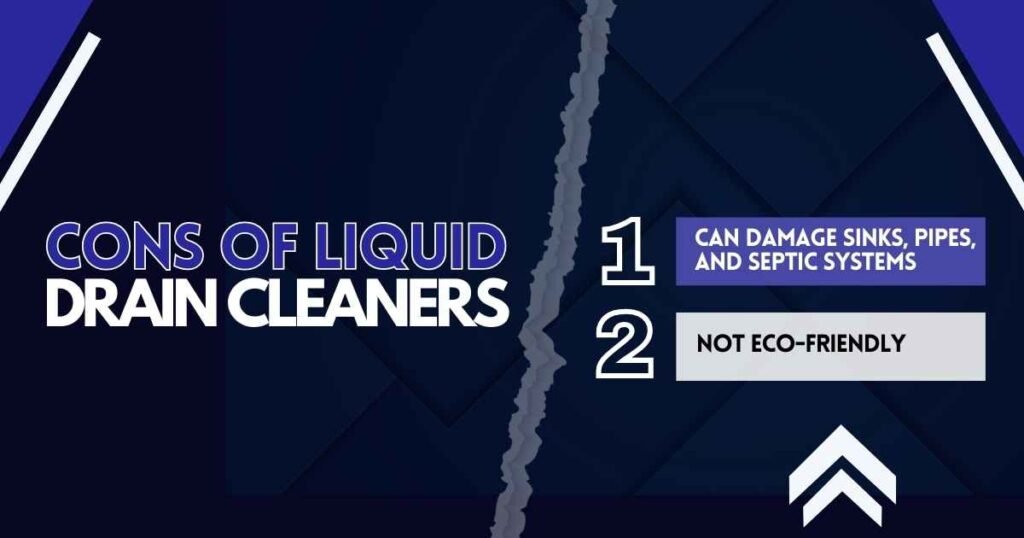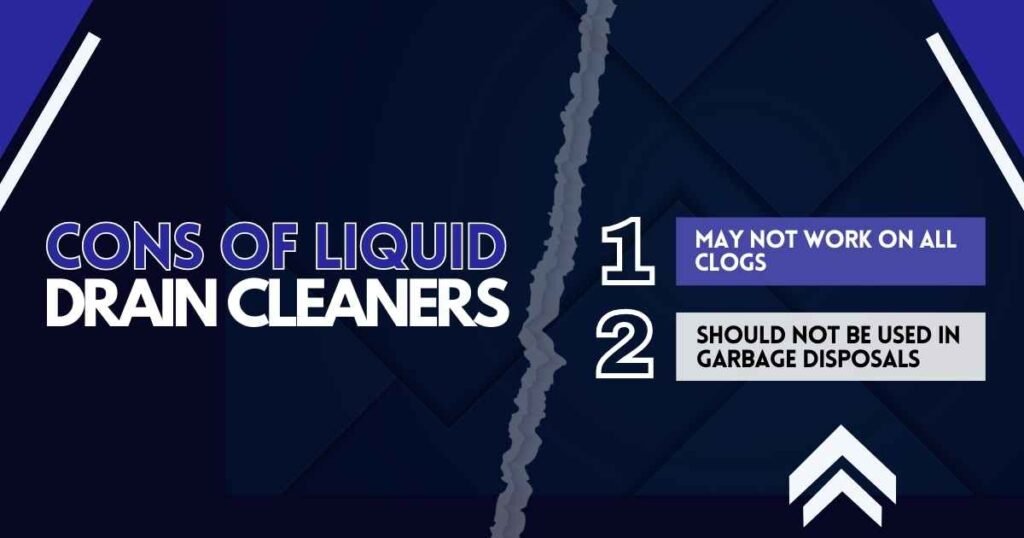You see water slowly swirling around the drain, and your first reaction is to grab the liquid drain cleaner. It’s a common go-to for a reason. When there’s hair stuck in the bathroom drain or food buildup in the kitchen sink, liquid drain cleaner offers a fast, easy, and affordable fix.
However, sometimes you might reach for the “plumber in a bottle” when the real problem is something bigger, like broken pipes.
What is a Liquid Drain Cleaner?
Liquid drain cleaner is a chemical product, often containing ingredients like sulfuric acid, sodium hydroxide, or bleach. These chemicals help break down clogs in your drains. However, they can be dangerous if not used properly, so it’s important to carefully follow the instructions on the bottle.
If you’re unsure about using it, or if you think the clog might be too big for the cleaner to handle, it’s better to call a professional plumber for help. So, how does drain cleaner work? Depending on the type you use, the chemicals react inside the drainpipe, creating heat and gas that break up grease and oils, allowing water to flow freely again.
3 Types of Drain Cleaners
There are different types of drain cleaners, each designed to tackle specific clogs. They use chemicals to break down materials like hair, grease, or food and turn them into smaller pieces that can be flushed away. Choosing the right cleaner helps prevent pipe damage and keeps your drains clear.
1. Oxidizing Drain Cleaners
Oxidizing drain cleaners are a great choice for clearing food clogs in the kitchen or hair clumps in the bathroom and shower drains. These cleaners usually contain chemicals like bleach, nitrates, or peroxides. They are denser than water, which helps them sink through standing water and reach the clog.
Once the cleaner comes into contact with the blockage, it reacts by oxidizing the organic material, taking electrons from it. This process releases gas and heat, which helps break down the clog into smaller pieces. Oxidizing cleaners are especially effective for clogs caused by food or hair. However, they may not work well on grease or heavy buildups.
2. Caustic Drain Cleaners
Caustic drain cleaners come in both liquid and powder forms. The main ingredient in these cleaners is sodium hydroxide (also called lye), which helps break down fats, oils, and grease. The cleaner heats up and gives electrons to the clog, turning greasy substances into a soap-like substance that can easily dissolve in water.
Caustic cleaners are helpful for dealing with long-term buildup, such as grease from kitchen drains or soap scum in bathroom drains. They are also useful when clogs are caused by food particles that have stuck together over time. However, caustic cleaners can be dangerous to handle. Sodium hydroxide is highly corrosive and can burn your skin, so it’s important to use gloves and avoid direct contact.
3. Acidic Drain Cleaners
Acidic drain cleaners are the strongest and most powerful type of drain cleaner, but they should only be used by professional plumbers. These cleaners contain sulfuric acid, which is very dangerous and can cause severe burns to the skin. They also create a lot of heat when mixed with water, which helps melt the material blocking the drain.
While they are effective at breaking down tough clogs, acidic cleaners can also harm your pipes, especially older ones, and cause damage over time. Because of the risks involved, acidic drain cleaners should only be used when other, safer options have failed. These cleaners should be used by professionals only. If you’re unsure which cleaner to use, it’s best to call a plumber for help.
Pros of Liquid Drain Cleaners
Liquid drain cleaners offer a quick and affordable way to tackle clogs, but they have some limitations. Here are five reasons why liquid drain cleaners can be useful, along with some extra details to consider before using them.

1. Quick and Easy to Use
Liquid drain cleaners are very simple to use. You just pour the cleaner into the drain, follow the instructions on the label, and wait for about 15 to 30 minutes.
During this time, the cleaner works to break down the clog. It can dissolve common blockages like food scraps, soap, hair, or grease. This makes it an ideal option when you need a fast solution without much effort.
2. Affordable Option
Liquid drain cleaners are usually priced between $5 and $15, making them an affordable choice compared to calling a plumber. If you have a minor clog, it’s a cost-effective way to try fixing the problem yourself.
However, keep in mind that if you don’t know the exact cause of the clog, liquid drain cleaner may not work. Hiring a professional plumber can be more expensive (around $220), but they have the experience to correctly diagnose and fix the issue.

3. Effective on Certain Types of Clogs
Liquid drain cleaners are great for clearing clogs caused by organic materials like hair, grease, and food. They are especially useful if you’re dealing with buildup in kitchen sinks (like leftover food or grease) or bathroom drains (where hair and soap scum tend to collect).
This type of cleaner can dissolve these materials and restore proper drainage, making it easier to prevent future blockages.
4. Convenient for Home Use
These cleaners are easy to find at grocery stores, hardware stores, and online. You don’t have to schedule an appointment with a plumber, which means you can tackle the clog immediately.
The process is straightforward, and you can handle it without needing any specialized tools or experience. It’s a convenient solution when you need to fix the problem right away.
5. Works for Minor Blockages
Liquid drain cleaners are effective for smaller blockages, such as slow-moving drains or standing water in showers. For minor issues that don’t require professional intervention, these cleaners can clear the clog without much hassle.
However, they might not be powerful enough for severe clogs or larger blockages, in which case you may need to consider other methods or call a plumber for help.
Cons of Liquid Drain Cleaners
While liquid drain cleaners can be effective in clearing clogs, they can also cause damage if used incorrectly. If you’re facing a stubborn clog, it may be best to call a plumber to check for more serious issues that a store-bought drain cleaner can’t fix.

1. Can Damage Sinks, Pipes, and Septic Systems
Always read the label to make sure your liquid drain cleaner is safe for your pipes, sink, or septic system. Some chemicals can harm the porcelain or enamel of your sink, so pour carefully.
Liquid drain cleaners may also corrode older pipes, especially those in homes built before the 1970s. If you’re unsure, try using a plunger first. For septic systems, these cleaners may kill helpful bacteria, leading to waste buildup. Hiring a plumber is the safest option to avoid costly damage.
2. Not Eco-Friendly
Many drain cleaners contain chemicals that can harm the environment, including water supplies. Plus, the plastic bottles end up in landfills.
Fortunately, there are now more biodegradable options available, such as enzymatic cleaners, which use natural bacteria and enzymes to break down clogs. Look for these greener alternatives if you’re concerned about the environment.

3. May Not Work on All Clogs
Liquid drain cleaners aren’t guaranteed to work on every clog. If you’re dealing with hair stuck in the drain or an item like a toy flushed down the toilet, no drain cleaner will help.
Sometimes, liquid cleaners clear a clog temporarily, but it may come back. They can’t fix more serious problems, like broken pipes or a damaged sewer line.
4. Should Not Be Used in Garbage Disposals
Liquid drain cleaners can be too harsh for garbage disposals, potentially damaging the pipes or causing them to deteriorate. “We do not recommend using drain cleaners in garbage disposals because they can damage the pipes,” says Asya Biddle, an expert from The Dust Busters janitorial company.
Garbage disposal clogs are often caused by larger items that drain cleaners can’t break up. If your disposal is clogged, try plunging the drain or using a homemade cleaner with bleach, vinegar, and hot water. If these methods don’t work, it’s best to call a plumber.
Alternatives to Liquid Drain Cleaner
Before calling a plumber, try these DIY methods to clear a clog. They’re better for the environment and your health, and you may already have the ingredients. Regular drain maintenance can also save you time and money in the long run.
- Dish Soap and Hot Water: If your clog is caused by grease, try dish soap and hot water. Boil about half a gallon of water, mix in a few tablespoons of dish soap, and slowly pour it down the drain. You may need to repeat this a few times to fully clear the clog.
- Baking Soda and Vinegar: Baking soda and vinegar are great for cleaning drain pipes without harsh drain cleaner chemicals. Start by pouring half a cup of baking soda and half a cup of white vinegar into the drain. Plug the drain and let the mixture sit for about an hour. Afterward, pour boiling water down the drain to help loosen the clog. Repeat this until the drain is clear.
- Baking Soda and Salt: For tougher clogs, a mix of baking soda and salt can help break up the blockage. Combine half a cup each of baking soda and salt, then pour it down the drain. Let it sit for at least 30 minutes, or overnight for best results. Afterward, flush the drain with boiling water to clear the clog.
Quick Solutions, Long-Term Care
When considering liquid drain cleaners, it’s important to weigh both the pros and cons. While they offer a quick solution, relying on them too often may lead to long-term damage. Like taking shortcuts to save time, it might seem convenient at the moment, but it can have consequences down the line. Like balancing work and rest for a healthy life, drain care requires using the right tools at the right time to protect your home and its systems.
If you’re unsure about using liquid drain cleaners or need help with your plumbing, Vegas Plumbing Pros is here to help. Our expert team provides reliable, long-term solutions to keep your drains and pipes in top shape. Contact us today for a professional inspection and prevent costly damage down the road!
FAQs
How long does liquid drain cleaner take to work?
Most liquid drain cleaners take 15 to 30 minutes to work. Check the label for specific instructions to avoid damaging your pipes. Alternative methods like baking soda, salt, vinegar, or boiling water may take longer since they are gentler than liquid drain cleaners.
What happens if you leave the drain cleaner for too long?
If you leave drain cleaner in too long, it can damage your pipes. The chemicals can cause cracks, rust, and leaks in the pipes. They may also harm plumbing fixtures and cause environmental damage if not rinsed away quickly.
What is the best drain cleaner?
The best drain cleaner depends on your needs. For a natural and safe option, try using baking soda and vinegar. They work well for most clogs and won’t harm your pipes. If you need a stronger cleaner, look for an enzymatic drain cleaner, which uses natural enzymes to break down the clog without harsh chemicals.
What happens if you leave drain cleaner in too long?
If you leave drain cleaner in too long, it can damage your pipes. The chemicals can eat away at the material, causing leaks or cracks. It may also create harmful fumes or cause clogs to worsen. Always follow the instructions and avoid leaving it in for too long.



